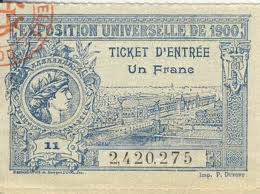The daguerreotype (named after the French artist Daguerre who invented it) was an instant success. Anyone could have a portrait in no time at all at a reasonable price. There were drawbacks; the images had no color and were small but motivated younger artists to explore. They worked on larger canvasses, most often outside the studio, and started breaking down the colors.
At the time Paris, with its strict neoclassic rules, was the uncontested center of art in Europe and the unconventional paintings were banned from salons and exhibits. In retaliation the rejected artists organized their own "off" exhibit, Salon des refusés, but there was little support. They were discovered during the 1st World’s Fair; L'Expostion Universelle de Paris, by collectors from the United States.
Electricity opened new opportunities to experiment with color, and at the turn of the century the active nightlife of Paris became a central theme. However, the lighthearted scenes of people enjoying life would be undermined by politics as Europe braced itself for a major conflict with Germany. During this time many German artists, mathematicians and intellectuals immigrated to the United States.
The social discrepancies of the Industrial Revolution and the two World Wars had a profound effect on artists. Disenchanted and disillusioned they questioned their role in society and wrote manifestos to back their political views.
All sorts of materials were invented for the wars that opened new creative possibilities. Classic ideals were definitively closeted and exchanged with the goal to provoke a response. Artists were inspired by the writers Jean-Paul Sartre and Simone de Beauvoir who created the "Existentialist Movement" in France before the 2nd World War. Existentialism is founded on personal responsibility and the use of a person’s creative powers as a guide.
Existentialist philosophy can be traced back to the 17th century, when Pascal refuted Descartes’ rationalist theory as unrealistic. He maintained that humans are full of contradictions as they have to deal with both the body and the mind. Kierkegaard believed individual values superseded the rules of society, and that religion was necessary to keep folks from despairing.
Nietzsche, on the other hand, was adamant in his refusal to accept any compromise on the hard facts. “God is dead,” he said. Heidegger was as pessimistic as Nietzsche about the apparent senselessness of life, but encouraged people to choose a goal and follow it passionately.
The only thing rational about art is the way it follows the ebb and tide of civilizations. While artists throughout history faithfully portrayed the period they lived in they were constantly pushing the limits of their imagination. The best definition to my mind comes from a painter who called art a series of corrections.
If only we could adapt this concept to life while we search for that moment of perfect balance.
Modern art and Existentialism
1900s
Three important events transformed art after the American and French Revolutions. The invention of the daguerreotype in 1836, the invention of the electric light bulb in 1878, and the 1st World’s Fair in Paris in 1900.
